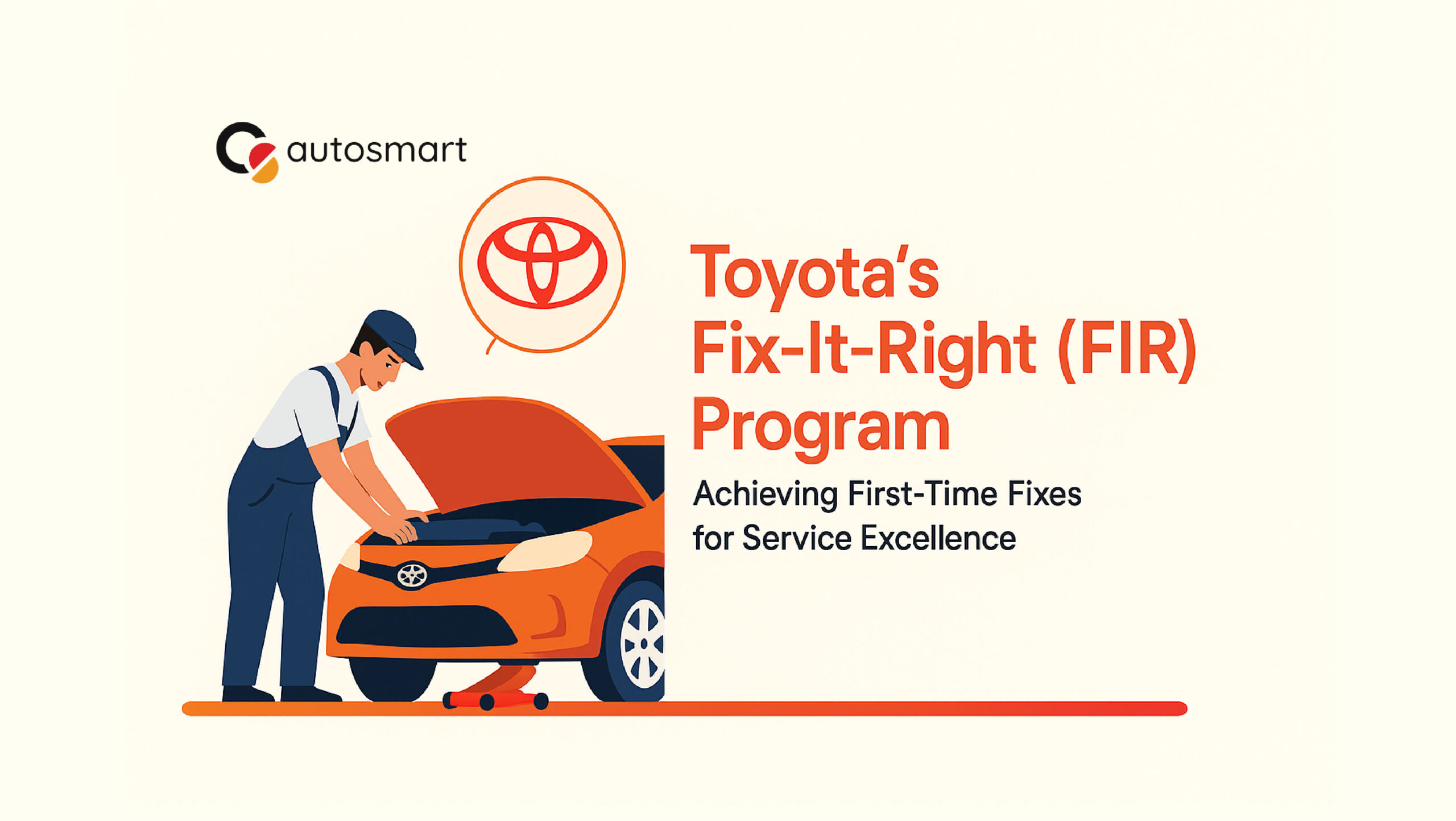Nothing frustrates a customer more than having to return for the same repair. Repeat visits damage trust, cost time, and create avoidable expenses for both the customer and the dealership. Toyota’s Fix-It-Right (FIR) standard is designed to address this by promoting accurate diagnosis and repair during the vehicle’s first visit to the service center.
Let’s look at how dealers can meet that and how AutoSmart Audit supports that goal.
What Fix-It-Right Means and Why It Matters
Fix-It-Right is a widely adopted after-sales standard that encourages getting repairs done correctly on the first attempt. It is not just a slogan. Toyota promotes this standard across its global dealer network as part of its broader commitment to quality and customer satisfaction.
The purpose is to reduce repeat repairs, increase customer confidence, and manage warranty costs effectively. A high-performing dealership often maintains a first-time fix rate between 85 and 95 percent, which is considered an industry benchmark.
Core Practices That Support First-Time Fixes
Improving first-time fix rates requires a consistent and structured approach. Dealerships that excel in FIR tend to follow these fundamental practices:
- Accurate diagnosis: Identifying the root cause of the issue during the initial inspection.
- Qualified and trained technicians: Equipped with the latest repair information and tools.
- On-hand parts availability: Ensuring that common and critical parts are ready when needed.
- Final quality checks and test drives: Verifying the repair before handing the vehicle back to the customer.
- Reviewing repeat repairs: Investigating and correcting patterns that indicate recurring issues.
Why It Pays Off for Dealerships
Focusing on first-time fixes brings clear business benefits to service departments:
- Higher customer satisfaction as clients feel their time and concerns are respected.
- Lower operating costs due to reduced rework, fewer labor hours spent on repeat issues, and lower warranty payouts.
- Improved reputation in the local market because reliable service keeps customers coming back.
- Technician pride and accountability from successfully resolving problems the first time.
Following FIR standards is not just about meeting corporate requirements. It supports better business outcomes across the board.
Why OEM Managers Track This Metric Closely
For OEM field managers and compliance teams, the Fix-It-Right rate is a critical performance indicator. It helps answer important questions:
- Is service quality consistent across all locations?
- Are customers likely to recommend the dealership based on their service experience?
- Where should training, coaching, or process improvements be directed?
- Is the dealership delivering on the brand’s promise of reliability and trust?
FIR is more than just a number. It reflects the health of after-sales operations and influences customer loyalty and brand perception.
Using Digital Tools to Support FIR Goals
Tracking FIR performance manually can be slow, inconsistent, and prone to missed details. Relying on paper audits or static spreadsheets creates delays in spotting problems and limits visibility into daily operations.
AutoSmart Audit addresses this challenge by providing a digital platform that helps both dealerships and OEM managers monitor Fix-It-Right performance more efficiently. It offers several practical features:
- Live tracking of first-time fix rates across technicians or departments.
- Standardized checklists that ensure audits are consistent and complete.
- Instant alerts when key performance indicators drop below target levels.
- Historical trend data that shows patterns and supports root cause analysis.
- Clear action planning tools to improve weak areas with accountability built in.
By providing accurate and real-time data, AutoSmart Audit supports ongoing performance improvement without adding extra manual work.
Combined Benefits for Dealers and OEMs
Whether you manage a single dealership or oversee a network of locations, improving FIR performance provides lasting benefits:
- Increased customer retention as clients come to trust your service reliability.
- More efficient technician workflows that reduce downtime and error rates.
- Fewer warranty claims and lower rework costs.
- Better insights for coaching and training by identifying where support is needed.
AutoSmart Audit helps translate Fix-It-Right goals into daily actions. It becomes easier to know who needs help, why, and how to improve performance in a measurable way.
Conclusion
Every service operation aims to deliver high-quality work, but only those with clear processes and performance tracking can consistently achieve first-time fixes. Toyota’s Fix-It-Right standard highlights what many customers already expect, that the issue will be resolved during the first visit.
Reaching that standard means building better habits, monitoring real data, and acting quickly when something falls short. Tools like AutoSmart Audit give service teams and compliance managers the visibility and structure they need to meet that goal.
When service quality improves, customers notice. And when repeat visits drop, so do costs. That is a win for everyone involved.
Disclaimer: This blog is based entirely on publicly available information related to Toyota’s Fix-It-Right program. It is not affiliated with, approved by, or endorsed by Toyota Motor Corporation. Any mention of AutoSmart Audit is included to illustrate how digital tools can support commonly accepted industry practices and goals related to first-time fix performance.

Naseef Umar is the Founder & CEO of AutoSmart Technology, a SaaS platform digitizing audits for OEMs, distributors, and dealer networks. With prior experience at Toyota (Abdul Latif Jameel) and a background in IT and Industrial Management, he writes about audits, operational discipline, and building SaaS products for enterprise customers across markets.




